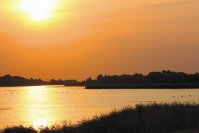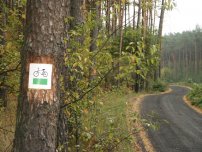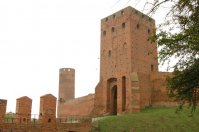Mazovia
Mazovia
![]() The economic leader with a thousand-year-long tradition.
The economic leader with a thousand-year-long tradition.
The historic buildings merged into the modern, sky-reaching Warsaw. The academic area surrounded with a huge agricultural terrain. We are inviting you to Mazovia - the region of contracts and big opportunities.
 We suggest to begin our excursion from Płock, the oldest town in the region. Płock is located in the middle of Mazovia, at the borderland of Kotlina Płocka and Pojezierze Dobrzyńskie.
We suggest to begin our excursion from Płock, the oldest town in the region. Płock is located in the middle of Mazovia, at the borderland of Kotlina Płocka and Pojezierze Dobrzyńskie.
The burg city, established on the slope above the Vistula River, used to be the seat of bishops, Mazovian dukes and Polish lords. It is an amazing place and as such – it has been the inspiration for poets, painters and cameramen. Its magic is hidden in its unique beauty created by the history and the present.
 In Pułtusk, only 60 kilometers away from Warsaw, inside the walls of the XVth c. Castle located on the brink of Puszcza Biała, at the blue Narew- there is the Polonia House (now a beautiful hotel). The city is famous for the longest (380 kilometers) cobbled square in Europe.
In Pułtusk, only 60 kilometers away from Warsaw, inside the walls of the XVth c. Castle located on the brink of Puszcza Biała, at the blue Narew- there is the Polonia House (now a beautiful hotel). The city is famous for the longest (380 kilometers) cobbled square in Europe.
Żelazowa Wola is a small town located in the Mazovian plateau, on the outskirts of Sochaczew. There is a beautiful manor – the place where the world famous pianist and composer, Frederic Chopin, was born. The interior of the museum reflects the character of the epoch; however, the Chopins’ manor XIXth c. equipment has not survived till today.
The precincts of Grójec are the biggest fruit growing areas in Poland. They call this place the biggest orchard in Europe, and it is said that every third apple in Poland is grown Grójec. These apples are of unusual acidity and beautiful red color - the features ensured by the unique microclimate of the area.
 The Zegrze Reservoir [Zalew Zegrzyński] is a place for recreation for Warsaw and neighboring citizens due to the many guest houses and water sport facilities located mainly in Zegrz, Zegrzynek, Białobrzegi and Rynia. Around the water reservoir there are cycling paths.
The Zegrze Reservoir [Zalew Zegrzyński] is a place for recreation for Warsaw and neighboring citizens due to the many guest houses and water sport facilities located mainly in Zegrz, Zegrzynek, Białobrzegi and Rynia. Around the water reservoir there are cycling paths.
Near Warsaw there is the Kampinos Forest [Puszcza Kampinoska] – the Kampinos  National Park [Kampinowski Park Narodowy] one of the most important forest complexes in Poland. In the forest growing on the sand dunes there live such wild animals as elks, lynxes, beavers and badgers.
National Park [Kampinowski Park Narodowy] one of the most important forest complexes in Poland. In the forest growing on the sand dunes there live such wild animals as elks, lynxes, beavers and badgers.
The Bug Landscape Park [Nadbużański Park Narodowy], located in central-eastern part of the Mazowieckie Province, is characterized by the variety of landscape yet its most important value is the Bug valley, with many oxbow lakes and islands in the current and sandbanks and slopes. Circa 1/3 of the park’s area is covered by forests - the remains of the old virgin forests. Other interesting places are the ruins of the old castles of Mazovian dukes in Ciechanów and Czersk, the stronghold in Modlin, the river basin of Narew or Konstancin Jeziorna - the beautiful health resort near Warsaw.
 The Mazovian Lanscape consists of heights and plains, crossed out by the wide valleys of the queen of the Polish rivers – the Vistula, the symbolic Bug river, the historic Bzura river, and picturesque rivers: Narew, Pilica and Wkra.
The Mazovian Lanscape consists of heights and plains, crossed out by the wide valleys of the queen of the Polish rivers – the Vistula, the symbolic Bug river, the historic Bzura river, and picturesque rivers: Narew, Pilica and Wkra.
There are only a few, mainly post-glacial lakes, like the one near Gostynin and the lakes in the Pojezierze Dobrzynskie. The forests cover more than 20% of the area, where the green pines and long-lasting oaks predominate the landscape.
![]() Mazovia is the most often visited region of Poland.
Mazovia is the most often visited region of Poland.
 It attracts circa 5 million tourists a year, which is almost 30% of the total volume of the foreign tourism in our country. The Mazowieckie Province is also the biggest in terms of the area and population, and it is thus sometimes compared to Denmark. It occupies 36 thousand square kilometers i.e. over 11% of the area of Poland. It is inhabited by at least 5.2 million people. The density of population is 145 persons per square kilometer.
It attracts circa 5 million tourists a year, which is almost 30% of the total volume of the foreign tourism in our country. The Mazowieckie Province is also the biggest in terms of the area and population, and it is thus sometimes compared to Denmark. It occupies 36 thousand square kilometers i.e. over 11% of the area of Poland. It is inhabited by at least 5.2 million people. The density of population is 145 persons per square kilometer.
Mazowieckie Province was created as a result of the administrative reform of 1999, from the former Warszawskie Province, and parts of provinces such as the radomskie, ciechanowskie, siedleckie, płockie, skierniewickie, bialskopodlaskie and łomżyńskie. It regained the shape of the Warszawskie Province before 1957. Its borders do not cover the historic Mazovian region. Its eastern part includes the Podlasie lands, the northern part covers the Kurpie, and the southern part – the radomskie land. Administration divides it into 5 townships, and 37 country districts, and 314 communes. There are 85 towns with the total 65% of population. The biggest cities here are Warsaw (over 2.8 million of inhabitants), Radom, Siedlce, Ostrołęka, Płock, Pruszków, Legionowo, Ciechanów. The smallest city in the province, as well as in Poland, in respect of the number of inhabitants is Wyśmierzyce, populated by 90 inhabitants only.
![]() The Mazowieckie Province belongs to the most internally varied
The Mazowieckie Province belongs to the most internally varied
economic regions.
Over 21% of the domestic gross product is manufactured here and it is the most in the country. Warsaw, with the “team” of the nearest towns, and Płock and Siedlce, are the leaders. Trade, telecommunication, financial and IT services, insurances, vehicle and petrochemical industry flourish in the biggest cities. At the same, the province is the biggest agglomeration of rural population (1.8 million persons) – every fourth person being employed in agriculture. Over the half of the province area is occupied by the arable lands, and therefore vegetable and fruit-growing develop best, especially near Grójec and Warka.
![]() The province has its own resilient science and education background with the biggest number of students in the country (over 350 thousand students).
The province has its own resilient science and education background with the biggest number of students in the country (over 350 thousand students).
The biggest academic center is Warsaw, but the schools are also located in Płock, Pułtusk, Radom and Siedlce. Over 18 higher schools with almost all faculties are seated there. The most famous are: the University of Warsaw (established in 1816), the Technical University of Warsaw (with tradition going back to 1826), the Warsaw School of Economics, and the Warsaw University of Life Sciences. There are also 44 non-public schools.
Finishing our Mazovia excursion, we are inviting you to the capital city. The obligatory point of this trip should be the visit at the Warsaw Old Town [Starówka]. While walking down its old streets, and visiting its stylish cafes, you shall feel its relaxing space. Razed to the ground during the II World War, the Old Town was rebuilt to match its pre-war look as closely as it was possible, and now it is listed as a point in the World Culture and Natural Heritage List of UNESCO. There are also many precious buildings which remained after the War without significant damages, such as the Palace in Wilanów (the summer residence of the king Jan III Sobieski, who held back the invasion of the Turks in Europe in XVIIth c.), the Visitationists’ Church [kościół Wizytek] and the Assumption Carmelite Church [Kościół Karmelitów pw. Wniebowzięcia] at the stylishly redecorated Krakowskie Przedmieście; and the Presidential Palace. From the Old Town, you should go for a walk along the Royal Route [Trakt Królewski] - the most representative part of the city. This route connects the Royal Castle with the palaces in Łazienki and Wilanów. It captivates with the beauty of the palaces, churches, middle-class tenement houses, and majesties of government seats. The walk along this route is the time-travel in the past centuries, letting the traveler familiarize with the history. Want more impressions? Go to the old part of Praga, with the unique climate of Warsaw where many tenements houses remember the times before the War. The foreign guest may be interested in the socialist realism remains: the Marszałkowska Dzielnica Mieszkaniowa (MDM), or the blocks near East Train Station [Dworzec Wschodni]. And if you want to watch the capital city’s panorama, you should do it on the 11th level of the Palace of Culture and Science which, like the Eiffel Tower, is visible from almost every place in Warsaw. The Warsaw unique is also its contrast given by the close proximity of big city buildings, skyscrapers and monuments, and the greenery of many squares, parks and gardens. There the busy inhabitants are able to relax for a while, listen to the birds' voices and think about… nothing.
This big city agglomeration is also the asylum for many species of protected animals- butterflies, lizards and reptiles. However, the most numerous are the wild birds here. Although they have a shelter in the tree branches and bushes at the green and still natural bank of the Vistula river, the symbol of which is the couple of Peregrine Falcon which some years ago made nests at the top of the Palace of Science and Culture, in the very heart of the city.
![]() Warsaw is also the center of cultural events.
Warsaw is also the center of cultural events.
There are numerous concerts, theatre performances, exhibitions and festivals, and the music contests such as the International Frederick Chopin Piano Competition, the International Festival of Contemporary Music “Autumn of Warsaw”, Jazz Jamboree, Warsaw Summer Jazz Days, the International Stanisław Moniuszko Vocal Competition, Mozart’s Festival, or the Old Music Festival – the events are well known all over the world – starting from America, to finish with Japan. There are also 30 big theatres with the most important – the National Theatre (established in 1765) and Teatr Wielki – the Polish National Opera (established in 1778) among. There are many museums and art galleries, both public and private, with the biggest ones: the Zachęta and the Centre for Contemporary Art Ujazdowski Castle. Worth seeing is the National Museum and its branches at the Royal Castle and the Wilanów Palace. Since 2004, the obligatory point of all trips has been the multimedia Warsaw Rising Museum. You must go there to find out why.
In the administrative capital city of Poland, the greatest number of the authority bodies such as the Ministries, Authorities and the Central Institutions, as well as Embassies have their seats. There are also the representations of foreign institutions, organizations and corporations. In Warsaw, the domestic communications roads cross. At the International Frederic Chopin Airport, land over 80% of passengers coming to Poland. The Warsaw City Center [Śródmieście], with the Warsaw Stock Exchange, is one of the most important business centers in the Middle Europe. - And it never sleeps…
Welcome to Mazowieckie Province!

